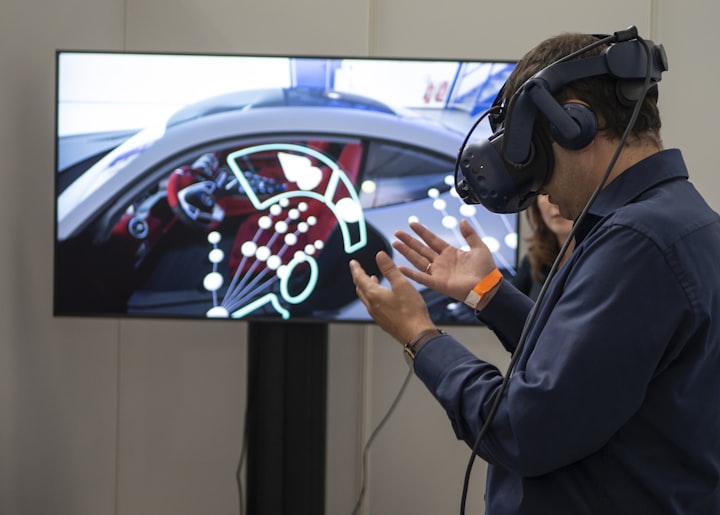Advancements in Virtual Reality (VR) and Augmented Reality (AR)
Advancements in Virtual Reality (VR) and Augmented Reality (AR)
Advancements in Virtual Reality (VR) and Augmented Reality (AR
Introduction
Virtual Reality (VR) and Augmented Reality (AR) are two rapidly evolving technologies that have transformed the way we perceive and interact with digital content. While both VR and AR offer immersive experiences, they differ in their approach. VR creates a fully simulated environment, transporting users to a virtual world, whereas AR overlays digital elements onto the real world, enhancing the user's perception of reality. In recent years, there have been significant advancements in both VR and AR technologies, leading to exciting possibilities across various industries. This article explores the latest advancements in VR and AR and their potential applications.
Advancements in Virtual Reality (VR)
1. Improved Hardware: One of the key advancements in VR is the development of more sophisticated hardware. High-resolution displays, faster refresh rates, and wider field-of-view (FOV) have greatly enhanced the visual quality and realism of VR experiences.
2. Wireless VR: Traditionally, VR headsets required wired connections to powerful computers. However, recent advancements have led to the introduction of wireless VR headsets, offering freedom of movement and a more immersive experience without the constraints of cables.
3. Inside-out Tracking: Earlier, external sensors were used to track the user's movements in VR. But now, inside-out tracking systems are becoming more prevalent. These systems use built-in sensors and cameras on the VR headset to accurately track the user's position and movements, eliminating the need for external sensors.
4. Haptic Feedback: Haptic feedback technology has made significant progress in VR. By incorporating tactile sensations through gloves, suits, or controllers, users can now feel and interact with virtual objects, enhancing the overall sense of immersion.
5. Social VR: Advancements in VR have also enabled the development of social VR platforms. Users can now meet and interact with others in virtual spaces, creating a sense of presence and fostering collaborative experiences.
Advancements in Augmented Reality (AR)
1. Mobile AR: With the widespread availability of smartphones, AR has gained popularity through mobile applications. Advanced AR frameworks and software development kits (SDKs) allow developers to create AR experiences accessible through mobile devices, expanding the reach of AR technology.
2. AR Glasses: The development of AR glasses has been a significant advancement in the field. These lightweight, wearable devices overlay digital information onto the user's field of view, providing a seamless and hands-free AR experience.
3. Spatial Mapping and Object Recognition: AR has evolved to recognize and understand the physical environment more accurately. Spatial mapping and object recognition technologies enable AR devices to identify surfaces, objects, and even people, allowing for more realistic and context-aware augmentations.
4. Integration with IoT: AR is now being integrated with the Internet of Things (IoT) to create smart and interactive environments. By combining AR with IoT devices, users can interact with connected objects in their surroundings, enabling a more immersive and personalized experience.
5. AR in Industrial Applications: AR has found significant applications in industries such as manufacturing, maintenance, and training. AR overlays digital instructions or real-time data onto machinery or equipment, assisting workers in their tasks and improving efficiency.
6. Medical and Healthcare AR: AR is making notable strides in the medical field. Surgeons can now use AR overlays during complex procedures, providing real-time guidance and enhancing precision. Additionally, AR is being used for medical education and patient visualization, enabling better understanding and communication.
Future Possibilities and Impact
The advancements in VR and AR technologies have opened up a wide range of possibilities across various industries and sectors. Here are some potential applications and their impact:
1. Gaming and Entertainment: VR and AR have revolutionized the gaming and entertainment industry, offering immersive experiences and transforming the way people play and consume media.
2. Education and Training: VR and AR
have the potential to revolutionize education and training by providing interactive and engaging learning experiences. From virtual classrooms to simulated training environments, these technologies can enhance knowledge retention and skill development.
3. Architecture and Design: VR and AR are being utilized in architecture and design to visualize and simulate structures and spaces. Architects can walk through virtual buildings, and designers can overlay digital prototypes onto physical spaces, facilitating better design decisions.
4. Tourism and Travel: VR and AR can transport users to different locations, offering virtual tours and immersive travel experiences. Users can explore destinations and landmarks from the comfort of their homes, fostering virtual tourism.
5. Healthcare and Therapy: VR is being used for pain management, phobia treatment, and therapy sessions. Patients can be exposed to virtual environments that help alleviate pain, reduce anxiety, and aid in rehabilitation.
Conclusion
The advancements in Virtual Reality (VR) and Augmented Reality (AR) have brought us closer to realizing the full potential of these technologies. From improved hardware and wireless experiences to enhanced interactivity and integration with other technologies, VR and AR have evolved rapidly. The applications span across industries, including gaming, education, architecture, healthcare, and more. As these technologies continue to advance, we can expect even more exciting and transformative experiences that will reshape how we interact with digital content and our physical surroundings.







Comments
There are no comments for this story
Be the first to respond and start the conversation.